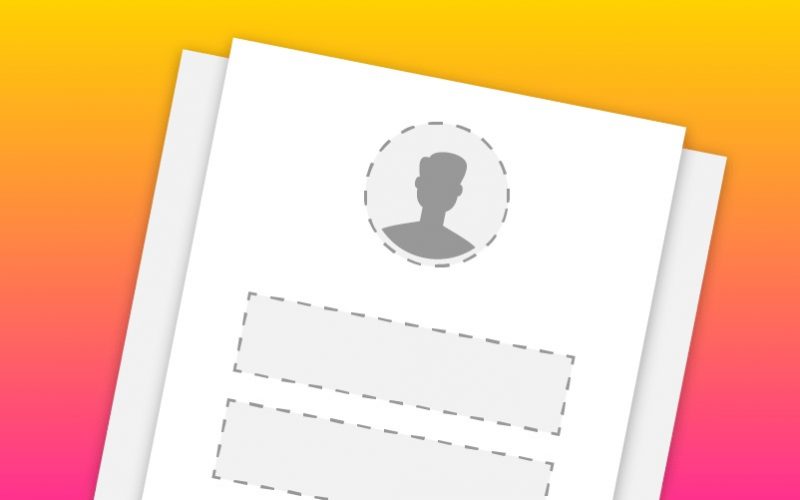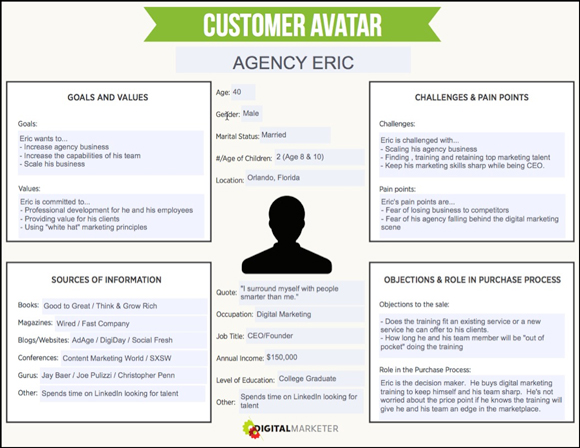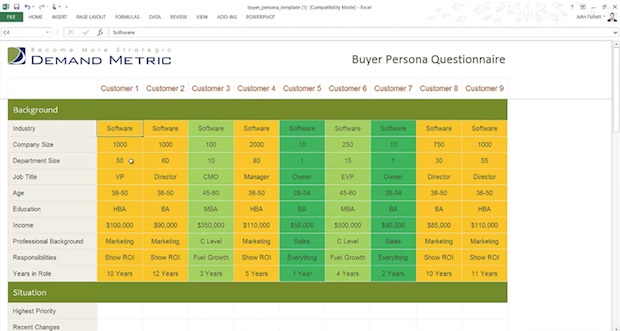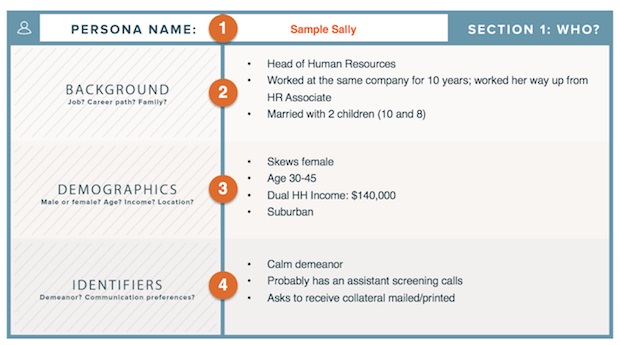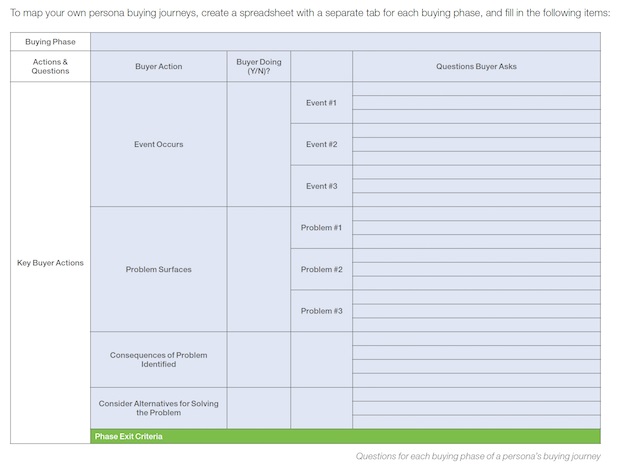Are you interested in creating a buyer persona for your company? The key to high conversions is explicitly defining your target consumer, as smart marketers know. We’ll show you how to develop a detailed buyer persona in this guide—with templates & tools.
To a large extent, it’s easy to get lost in the details of tracking your newest engagement numbers and marketing initiatives as a social marketer—or any marketer, for that matter. Buyer personas help you generate content that better targets your ideal client by reminding you to prioritize your audience’s wants and requirements over your own.
The table of content gives a quick rundown of what we’ll be talking about in this guide. To skip to a specific section, click on one of the links above.
Are you ready to begin with building your buyer persona? Let’s start with the basics. But before then, you can take a quick look at a simple buyer persona template below.
Now let’s get started…
What is Buyer Persona?
A buyer persona (sometimes referred to as a “customer avatar”) is a fictional character who represents a company’s ideal customer.
The goal of building a buyer persona is to acquire a clear picture of the people to whom you’re marketing. You can’t be sure that your offerings and marketing messages will be successful unless you have this nailed down. As a result, buyer personas are frequently based on actual consumers and/or thorough research.
It’s also worth noting that you might have multiple buyer personas. That’s absolutely OK! If your product or service is a good fit for multiple different “kinds” of customers, all you have to do is establish a buyer persona for each of them.
That way, you’ll know exactly which buyer persona(s) you’re speaking to whether you publish a blog post, email, or sales page (or even design a new product). As a result, your conversion rates will skyrocket.
Let’s get started on creating your own buyer persona or maybe your template now that you know what one is and why it’s so crucial for your business.
How to Build a Buyer Persona With Templates
When building a buyer persona, the first step is to conduct some research on your current customers (if you have any). These are the folks who have purchased from you, thus they are the most relevant to look at.
See what your marketing and sales teams can tell you about the demographics and other features of your current consumers; a list of questions is covered later in this post. Do not, however, rely solely on your marketing and sales teams for all of this information. To obtain all of the information you require, you will almost always need to run a survey.
#1. Customer/Prospect Survey
The best thing you can do is call your customers (or make a Skype call) and have a one-on-one conversation with them. This is something most firms like to do at least once or twice a year.
If you don’t already have any clients, talk to your email subscribers, social media followers, or any other leads you have. Simply explain that you are conducting research in order to better serve them, and ask if they are available for a brief 10-15 minute phone conversation.
If you don’t have any leads, look at the customers of your competitors. You can read internet evaluations and even try to find these people on social media to learn more about them.
#2. Online Research
While making a phone contact is the most effective technique to investigate your potential customers, there is another option: conducting research online.
This part may seem a little weird, but I like to pick a specific person and look up all of their social media profiles, publications, and other websites. A good place to start hunting for pieces of information to fill out your buyer persona is Facebook and LinkedIn.
Keep a document with links to all pertinent information on that person while you conduct your study. You’ll be able to return to these sites later while you work on your customer avatar.
Also, don’t limit yourself to what you see on the surface. Try to discover what makes that individual “tick” by reading between the lines (not just what they want the world to see).
#3. The Customer Avatar Exercise
Now, you’re ready to begin the customer avatar exercise now that you’ve acquired your data–both over the phone and online.
This is the point where you write down everything you know about your potential consumer.
The social media audience buyer persona templates above can help you with setting that up.
The goal is to construct a concrete persona that anyone in your company may utilize to have a better understanding of your target market.
Read Also: Buyer Persona: Best Easy Steps to Create One with Examples (+Free Tips)
Best Buyer Persona Templates & Tools
There are a plethora of free buyer persona templates, tools, and generators available on the internet, but we’ve compiled a list of the top options…
#1. Xtensio’s User Persona Creator
User Persona Creator by Xtensio is a useful tool that lets you enter the demographics, goals, problems, bio, motivations, preferred channels, and brands of your buyer persona. You can also customize the avatar by adding modules. To get started with the tool, create a free account.
#2. Digital Marketer’s Customer Avatar Worksheet
Digital Marketer’s Customer Avatar Worksheet is the buyer persona template used at OptinMonster. It comes in a simple PDF format that you can fill out on your computer and includes all of the critical areas to nail down.
#3. Demand Metric’s Buyer Persona Template
The Buyer Persona Template from Demand Metric is an Excel template with numerous tabs for different personas. It’s a fantastic method to see all of your target clients at a glance, together with all pertinent data. They’ve even supplied a video with step-by-step directions on how to do it.
#4. HubSpot’s Buyer Persona Template
The Buyer Persona Template from HubSpot has four sections for answering the big questions: who, what, why, and how. A guide for creating buyer personas is also included in this template.
#5. Marketing Persona Cheat Sheet from Marketo
The Marketing Persona Cheat Sheet from Marketo is unique in that it contains a fill-in-the-blank map to help you create buyer persona journeys. It also contains a buyer journey template and instructions on how to develop a buyer persona and journey.
#6. Filestage’s Buyer Persona Template
The Buyer Persona Template from Filestage is simple and elegant. Sections for a tag cloud, prototype, and product adoption group are among the template’s distinctive features. There’s also a PowerPoint version and a PDF version included.
7. “MakeMyPersona” Buyer Persona Generator
HubSpot’s MakeMyPersona is a buyer persona generator. Simply select the “Start Making My Persona” button, and a series of questions about your ideal consumer will be asked. They’ll send you a PDF with a headshot for your customer avatar after you’re finished.
#8. McorpCX Persona
Persona from McorpCX replaces static personalities with a highly engaging platform. You can use this tool to link personas to specific projects, organize your qualitative research data under each persona tab, and export your personas as PDFs for later use.
To try out the tool, they provide a free trial, following which options start at $99 a month.
#9. Akoonu
If you’re prepared to put money into Akoonu, you’ll find that it contains some of the most advanced features available. Akoonu not only allows you to design beautiful buyer personas but also integrates seamlessly with your MA/CRM software. It includes CRM Journey Map data, messaging and branding style guides, automatic content inventories, and more.
Akoonu’s free version is jam-packed with features that make collaboration, dashboard management, and audience targeting a breeze. It doesn’t hurt that they have a large research library and assistance features.
#10. Persona Topic Matrix (Inflow)
The Persona Topic Matrix from Inflow is a free tool for analyzing segment-based content gaps. While there isn’t much area for the “persona” component of a buyer persona in this tool, it’s fantastic for arranging your current and future content along the buyer’s journey. This is the solution for you if you want a tool that highlights your strengths and flaws while also assisting you in retargeting your content marketing.
While this tool fits perfectly into the topic of persona building, in order to use it properly, you must have pre-existing personas. This tool will assist you with your persona research and content strategy, but it will not create your personas for you.
#11. UserForge
UserForge is another free program with a great design. It allows you to develop extremely basic buyer personas that are limited to the following:
- Name
- Title
- Age
- Status
- Location
- Income
- Quote
- Goals
- Pain Point
UserForge, like Xtensio and PersonaDrive, is a technology that facilitates collaborative collaboration. UserForge 2.0 is also rumored to be on the horizon. We’ll have to wait and see if that gives this tool more capability.
#12. Up Close & Persona
Up Close & Persona is a simple little application that prompts you to answer a set of questions in order to generate buyer personas. Company Definition, Problem/Solution, and Buyer Definition are the three kinds of inquiries.
This tool is a little simplistic, and some of the questions are less helpful than others (for example, one of the questions after asking what problem your clients are facing is “What is the solution?”). Even so, if you’re looking for a quick way to get your staff or investors on the same page, this could work.
#13. Personapp
Personapp, like Up Close & Persona, is a very light tool. The appeal of this application is that it allows you to quickly create a simple character and offers choices for easy sharing throughout your entire company.
Personapp doesn’t provide much guidance, but if you’re prepared to enter all of the data yourself, it’s a useful tool.
#14. Buyer Persona Templates (Buyer Persona Institute)
The free buyer persona templates from Adele Revella are based on her “5 Rings of Buying Insight.” Essentially, it categorizes your buyer personas based on:
- Initiatives that should be prioritized
- Factors that influence success
- Perceived impediments
- The journey of the buyer
- Criteria for making decisions
These templates may sound more jargon-heavy than the others I’ve listed, but they still provide useful information about why your consumers make the decisions they do.
How to Find Interviewees for Buyer Persona Research
Finding people to speak with in order to figure out who your buyer persona is, is one of the most important phases in building your buyer persona(s).
That implies that you’ll need to conduct some interviews to learn more about your target audience’s motivations. But where do you look for interviewees? You should look into the following resources:
Make Use of Your Existing Customers
Because they’ve previously purchased your product and connected with your organization, your existing customer base is the ideal place to begin your interviews. At least some of them will most likely fit your target persona (s).
However, as we said earlier, don’t limit yourself to talking to folks who are enamored with your product and want to spend an hour raving about it (as good as that feels). Customers that are dissatisfied with your product will show additional patterns that will aid you in developing a thorough understanding of your personas.
For instance, you might discover that some of your dissatisfied customers have larger teams and require more collaboration features from your product. Alternatively, they may view your product to be excessively technical and difficult to use. In both cases, you gain insight into your product and the issues that your customers face.
Another advantage of interviewing current customers is that you may not need to provide them with a monetary incentive (such as a gift card). Customers enjoy being heard, and interviewing them provides them the opportunity to tell you about their lives, their problems, and their opinions of your product.
Customers enjoy having a say in the things they use. As a result of their participation in such interviews, you may find that they become even more loyal to your firm. But when you contact clients, make it obvious that your purpose is to obtain their feedback, and that your team values their input.
Make the Most of Your Prospects
Make sure to interview folks who haven’t bought your product and are unfamiliar with your brand. Because you already have their contact information, your current prospects and leads are a terrific option.
To figure out who would fit into your target personas, use the information you already have about them (such as information gathered through lead generating forms or website analytics).
Make Use of Your Contacts
If you’re going into new markets or don’t have any leads or customers yet, you’ll undoubtedly need to rely on some referrals to talk to people who might fit into your target personas.
Find people you’d like to interview and be introduced to through your network, which includes coworkers, existing customers, and social media contacts. It may be difficult to acquire a huge number of individuals this way, but you’ll almost certainly get some excellent interviews.
If you’re out of ideas, consider searching on LinkedIn for people who would fit into your target personas and seeing if any of the results share any connections with you.
Take Advantage of Third-Party Networks
There are a few third-party networks through which you can attract interviewers who are completely distant from your business. Craigslist allows you to publish job advertising for anyone looking for work, while UserTesting.com allows you to do remote user testing (with some follow-up questions).
UserTesting.com gives you less control over sessions, but it’s a wonderful tool for quickly recruiting users for user testing.
Let’s look at some recommendations for hiring interviewers now that we know how to identify them.
Tips for Recruiting Interviewees
Here are some tips to boost your response rates when reaching out to potential interviewers.
Make Use of Incentives
While incentives aren’t necessary in many situations (for example, clients who already want to talk to you), they do provide people a cause to engage in an interview if they don’t know you. A straightforward gift card is a simple solution.
State Unequivocally That This Is Not a Sales Call
When interacting with non-customers, this is extremely vital. Make it clear that you’re conducting study and only want to learn from them. You’re not attempting to persuade them to commit to a one-hour sales call; rather, you’re attempting to persuade them to share information about their lives, careers, and issues with you.
Make It Simple for People to Say Yes
Take care of everything for your potential interviewee, including suggesting times but remaining flexible, allowing them to choose a time straight away, and sending a calendar invitation with a reminder.
Determine the Number of Persons You’ll Need to Interview
For each persona you’re building, start with three to five interviews. If you already have a good understanding of your persona, that may be sufficient. On the flip side, you may need to do many interviews with each type of interviewee (customers, prospects, and strangers).
It’s a good rule of thumb to cease predicting what your interviewee will say when you start doing it. You’ll begin to see patterns as you go through these interviews.
In other words, you’ve interviewed enough people to identify and internalize these patterns once you start anticipating and forecasting what the subject will say.
Make a List of the Questions You Want to Ask
The interview is about to begin! It’s time to dive into your questions after the usual small talk and thank-yous. In order to develop a thorough persona profile, you’ll need to ask a variety of questions throughout persona interviews.
Persona Interview Questions: 20 Questions to Ask
The following questions are divided into eight categories; however, you are free to personalize this list by removing or adding additional questions that may be relevant to your target audience.
#1. Role Questions
- What is the name of your job?
- How would you describe a normal day?
- What are the responsibilities of your job?
- In your job, what skills and tools do you employ?
- What are the metrics used to evaluate your work?
- What qualifications do you need for your position?
- Who do you have to answer to if you have a problem? To whom do you answer?
#2. Company Questions
- What industry(s) does your company operate in?
- How big is your business (in terms of sales and employees)?
3. Goal Questions
- What is it that you are in charge of?
- What does it take to succeed in your current position?
#4. Challenge Question
- What are the most difficult issues you have to deal with?
#5. Watering Hole Questions
- How do you stay up to date on new job information?
- What magazines or websites do you follow?
- Do you belong to any organizations or social networks?
#6. Personal Background Question
- Describe your own personal traits (if possible, inquire about their age, marital status, and children).
- Give a brief overview of your academic background. What was your educational background, where did you go to school, and what did you study?
- Describe the steps you took to get to this point in your career. How did you come to be in the position you’re in now?
#7. Shopping Preference Questions
- Which method of communication with vendors do you prefer (email, phone, in-person)?
- Do you look up suppliers or products on the internet? If that’s the case, how do you go about finding out what you need to know?
- Give an example of a recent purchase that you made. What made you think about buying something, how did you evaluate it, and how did you decide to buy it?
#8. The “Why?” Question
This is the most important point to remember when doing a persona interview.
“Why?” should be the follow-up question to almost every one of the questions in the preceding list. You’re seeking to understand the goals, actions, and motivators of your consumers (or future customers) through these interviews. However, keep in mind that people aren’t always good at reflecting on their actions and telling you what motivates them.
So begin by asking a straightforward inquiry, such as “What is your greatest challenge?” Then devote some time to learning more about that person by digging deeper into that one inquiry.
Here is a more comprehensive list of buyer personas questions for your template.
How to Make the Most of Your Buyer Personas
It’s time to put your buyer personas to work now that you have the resources you need. Making a content map and considering it alongside your buyer’s journey is the ideal method to do this. Then you can consider the following:
- Is my content comprehensive enough to cover all stages of the buyer’s journey?
- What are the demands of my customers, and how can I better meet them?
- Is my content appealing to a variety of demographics in my audience?
- Is it possible to tailor or retarget my material in order to reach my desired demographic?
- What can I do to improve my messaging so that I don’t end up with unfavorable personas?
Remember that your buyer personas must be informed by data-driven research in order to receive a true return on your time investment.
Buyer Persona Templates FAQs
What is buyer persona template?
Buyer personas template is a list of details about your ideal customers. It will comprise demographics as well as the target buyer’s social, emotional, aspirational, and motivational characteristics.
What should be in a persona template?
A good template for buyer personas should include the following;
- Bare necessities.
- Pictures.
- Personality.
- Goals and motivations.
- Pain points.
